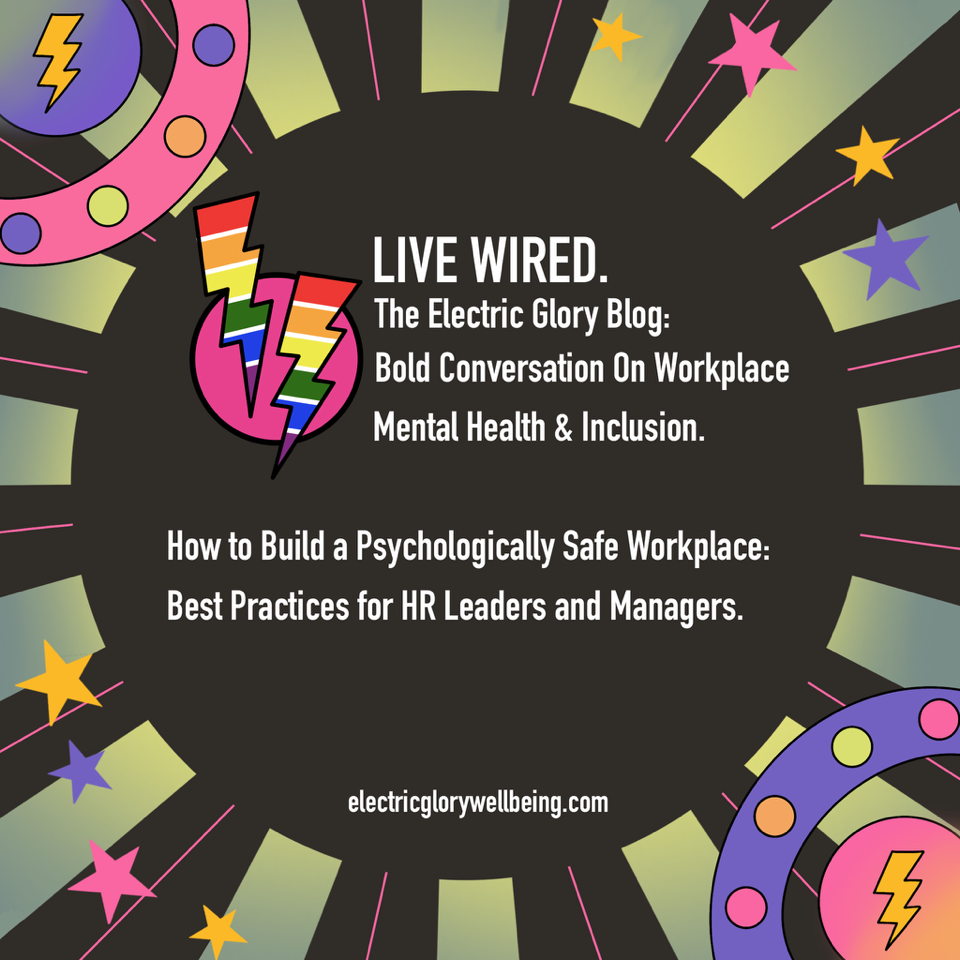How to Build a Psychologically Safe Workplace: Best Practices for HR Leaders

Rachael Hill
Psychological safety at work is the foundation of a successful and engaged workforce. It means creating a safe workplace culture where employees feel confident to engage in the team, share ideas and admit mistakes without fear of judgment or what feels like a punishment (Edmondson, 1999). For HR leaders, prioritising psychological safety is essential– not only for employee wellbeing but also for boosting productivity and fostering innovation within the organisation. In this blog, I explore why psychological safety matters and practical HR wellbeing initiatives toempower you to build a safer, more supportive organisation for your employees!
So, what do I mean by psychological safety at work? Psychological safety at work refers to an environment where employees feel safe to express themselves openly without fear of negative consequences. Coined by Harvard Business School professor Amy Edmondson, psychological safety enables teams to collaborate effectively, innovatively and learn from perceived failures (Edmondson, 1999). A safe workplace culture encourages honesty and transparency, setting the stage for greater employee engagement and wellbeing (Kahn, 1990). When people feel seen, heard and inspired – that’s when real change begins. In creating this environment, you raise your companies’ standards. When employees feel seen, supported and psychologically safe, evidence shows that they’re more engaged, more productive and more likely to stay with you.
Creating psychological safety at work isn’t just about avoiding negative outcomes –it’s about unlocking human potential. When employees feel safe to speak up and take risks, they bring their full creativity and passion to the workplace. Imagine a safe workplace culture where innovation isn’t stifled by fear but fuelled by open dialogue and mutual respect. That’s the kind of environment that not only drives results but makes work meaningful – every day.
But here’s the catch: psychological safety can’t be mandated or tik boxed in HR wellbeing initiatives. It’s built through authentic relationships and everyday, consistent action. Leaders feeling safe enough to admit when they don’t have the answers to something, teams actively listening without judgment and organisations prioritising empathy over efficiency. It requires a shift from ‘managing people’ to truly supporting them, which can feel like the unknown but ultimately leads to stronger, more resilient teams.
For HR leaders, investing in psychological safety at work is one of the smartest businesses moves you can make. It reduces costly turnover, lowers stress-related absenteeism and boosts engagement. Overall, leading to better customer experiences and improved income. Simply put, when employees feel psychologically safe, they perform better. It’s not just good for employee wellbeing – it’s essential for business success.
How can HR leaders influence psychological safety within an organisation? HR wellbeing initiatives that focus on psychological safety directly impact organisational success. Research shows that teams with high psychological safety are 20-25% more productive, experience lower turnover and enjoy higher creativity and innovation (Google, 2016; Gallup, 2017). When employees feel valued and safe, they are more likely to stay engaged and contribute their best work, making psychological safety a vital employee retention strategy and driver of wellbeing (Edmondson, 2019).
Best Practices to Foster a Psychologically Safe Workplace
1. Promote Open and Transparent Communication
Encourage honest feedback and active listening across all levels. Leaders should model vulnerability to build trust, creating an open communication culture where employees feel heard and respected (Brown, 2018). This trust-building in teams is key to a psychologically safe workplace.
2. Implement Regular Wellbeing Check-Ins and Support
Use one-on-one meetings, anonymous surveys and pulse checks to assess team climate and identify stressors early (Schaufeli & Bakker, 2004). Proactive HR wellbeing initiatives, including mental health resources, empower employees to voice concerns before issues escalate.
3. Train Managers on empathy and Inclusive Leadership
Provide managers with training in emotional intelligence and bias awareness to foster empathy (Goleman, 1995). Inclusive leadership training helps managers respond supportively to employee needs, promoting a culture of respect and psychological safety (Nembhard & Edmondson, 2006).
4. Encourage Learning from Failure
Cultivate a learning culture where mistakes are reframed as opportunities for growth (Edmondson, 2011). Reward innovation and constructive feedback to motivate teams and drive continuous improvement.
5. Measure Psychological Safety and Continuous Improvement
Regularly measuring psychological safety tools, this allows HR leaders to track progress and adapt strategies. Using workplace wellbeing metrics helps refine HR initiatives to better support mental health, build trust and sustain a safe workplace culture (Deloitte, 2020).
Psychological safety at work is not a luxury but a necessity for modern organisations. By embedding these best practices into HR wellbeing initiatives, leaders can foster a supportive environment where employees feel safe, valued and empowered to succeed (Edmondson, 2019). Prioritising psychological safety is key to unlocking higher engagement, productivityand long-term organisational success.
Building a safe workplace culture through psychological safety at work is more than an HR initiative – it’s a commitment to valuing and empowering every employee. As HR leaders, you have the unique opportunity to champion these vital wellbeing strategies and create environments where people feel truly supported and heard. By prioritising psychological safety, you’re not only enhancing employee wellbeing but also driving long-term organisational success. Embrace this responsibility with confidence and lead the way in fostering a resilient, engaged and high-performing workforce!
Ready to create a wellbeing culture?
To discuss employee wellbeing solutions that work why not book a free 20-minute consultation with Rachael to explore tailored insight-based wellbeing experiences for your staff.
Contact Page: https://electricglorywellbeing.com/contact/
Email: hello@electricglorywellbeing.com
Call: 0755 7354 296
References:
Brown, B. (2018) Dare to Lead: Brave Work. Tough Conversations. Whole Hearts. New York: Random House.
Deloitte (2020) Global Human Capital Trends 2020: The social enterprise in a world disrupted. Available at: https://www2.deloitte.com/us/en/insights/focus/human-capital-trends.html (Accessed: 6 July 2025).
Edmondson, A.C. (1999) ‘Psychological safety and learning behavior in work teams’, Administrative Science Quarterly, 44(2), pp. 350–383.
Edmondson, A.C. (2011) Teaming: How organizations learn, innovate, and compete in the knowledge economy. San Francisco: Jossey-Bass.
Edmondson, A.C. (2019) The Fearless Organization: Creating Psychological Safety in the Workplace for Learning, Innovation, and Growth. Hoboken: Wiley.
Gallup (2017) ‘State of the American Workplace Report.’ Available at: https://www.gallup.com/workplace/238085/state-american-workplace-report-2017.aspx (Accessed: 6 July 2025).
Google (2016) ‘Project Aristotle: Understanding Team Effectiveness.’ Available at: https://rework.withgoogle.com/blog/five-keys-to-a-successful-google-team/ (Accessed: 6 July 2025).
Goleman, D. (1995) Emotional Intelligence: Why It Can Matter More Than IQ. New York: Bantam Books.
Kahn, W.A. (1990) ‘Psychological conditions of personal engagement and disengagement at work’, Academy of Management Journal, 33(4), pp. 692–724.
Nembhard, I.M. and Edmondson, A.C. (2006) ‘Making it safe: The effects of leader inclusiveness and professional status on psychological safety and improvement efforts in health care teams’, Journal of Organizational Behavior, 27(7), pp. 941–966.
Schaufeli, W.B. and Bakker, A.B. (2004) ‘Job demands, job resources, and their relationship with burnout and engagement: A multi-sample study’, Journal of Organizational Behavior, 25(3), pp. 293–315.
DISCLAIMER: The writer is a Registered Mental health Nurse however, any information should not be considered as treatment or instructions & content should not be used in place of support.
The information contained on this page & in any third party websites referred to on this page is not intended nor implied to be a substitute for professional medical advice nor is it intended to be for medical diagnosis or treatment. Third party websites are not owned or controlled by Electric Glory and any individual may be able to access and post messages on them. Electric Glory is not responsible for the content or availability of these third party websites.
